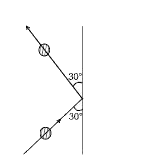तीन समतलीय बल →P,→Q तथा →R एक बिन्दु पर इस प्रकार कार्यरत हैं, कि →P व →Q तथा →Q व →R के मध्य कोण क्रमश: 150∘ व 120∘ है। P,Q ,R का अनुपात होगा-
1:2:3
1:2:√3
3:2:1
√3:2:1
The correct Answer is:D
Step by step video, text & image solution for तीन समतलीय बल vecP, vecQ तथा vecR एक बिन्दु पर इस प्रकार कार्यरत हैं, कि vecP व vecQ तथा vecQ व vecR के मध्य कोण क्रमश: 150^@ व 120^@ है। P,Q ,R का अनुपात होगा- by Physics experts to help you in doubts & scoring excellent marks in Class 12 exams.
Updated on:21/07/2023Topper's Solved these Questions
- न्यूटन के गति के नियम तथा घर्षण BOOK - ALLEN HINDICHAPTER - न्यूटन के गति के नियम तथा घर्षण EXERCISE - EXERCISE-IV Assertion & Reason
36 Videos
- न्यूटन के गति के नियम तथा घर्षण BOOK - ALLEN HINDICHAPTER - न्यूटन के गति के नियम तथा घर्षण EXERCISE - EXERCISE-II Previous Year Questions
31 Videos
- नाभिकीय भौतिकी तथा रेडियो सक्रियता BOOK - ALLEN HINDICHAPTER - नाभिकीय भौतिकी तथा रेडियो सक्रियता EXERCISE - Exercise-IV (Assertion & Reason)
25 Videos
- पदार्थो के गुण एवं तरल यांत्रिकी BOOK - ALLEN HINDICHAPTER - पदार्थो के गुण एवं तरल यांत्रिकी EXERCISE - EXERCISE-IV (Assertion & Reason)
34 Videos
Similar Questions
कथन : एक नियत वेग से सीधी सड़क पर चल रहे वाहन में चालक एक अजड़त्वीय निर्देश तंत्र में होता है।
कारण : वह निर्देश तंत्र जिसमें न्यूटन की गति के नियम लागू हो, अजड़त्वीय होता है।
View Solution0.5 kg की एक गेंद 12 m/s की गति से चलती हुई किसी दृढ़ दीवार से 30∘ के कोण पर टकराती है और इसी गति से और इसी कोण पर परावर्तित हो जाती है। यदि गेंद 0.25 सेकण्ड तक दीवार के सम्पर्क में रहती है, तो दीवार पर क्रियाकारी औसत बल होगा :-

View Solutionकथन: प्रोटॉन की अपेक्षा न्यूट्रान पदार्थ का अधिक भेदन करते है।
कारण :प्रोटॉन की अपेक्षा न्यूट्रॉन कुछ अधिक भारी होते है।
View Solutionकथन :- प्रत्यास्थ प्रत्यानयन बल संरक्षी बल हो सकते हैं।
कारण :- भार बढ़ाते हुए व घटाते हुए समान प्रतिबल पर उत्पन्न विकृति के मान क्रमशः भिन्न-भिन्न होते हैं
View SolutionIf vecP+vecQ=vecR and vecP-vecQ=vecS , prove that vecR^2+vecS^2=2(vecP^2+vecQ^2)
View SolutionThree vectors →P,→Q and →R such that ∣∣→Q∣∣=A√2 and the angles between →P and →Q,→Q and →R,→R and →P are 90∘,150∘,120∘ respectivlely. Find the value of ∣∣→P∣∣=
View SolutionMagnitudes of vectors →P,→Q and →R are equal, If →P+→Q+→R=0, then angle between →Rand→Q is α while if →P+→Q=→R, the angle between →R and →P is β, then :
View SolutionIf vecP+vecQ=vecR" & "vecR is perpendicular to vecP . define angle between vecP" & "vecQ" if " vec|P|=vec|R|-
View SolutionIf vectors →P,→Qand→R have magnitudes 5, 12 and 13 units and →P+→Q=→R, the angle between →Qand→R is :
View SolutionGiven that P= Q = R . If vecP + vecQ = vecR then the angle between vecP & vecR is theta_1 . If vecP + vecQ + vecR=vec0 then the angle between vecP& vecR is theta_2 . What is the relation between theta_1 and theta_2 ?
View SolutionThe sum of two forces vecP and vecQ is vecR such that |vecR|=|vecP| . The angle theta (in degrees) that the resultant of 2vecP and vecQ will make with vecQ is , _____________.
View SolutionLet →qand→r be non - collinear vectors, If →p is a vector such that →p.(→q+→r)=4and→p×(→q×→r)=(x2−2x+9)→q then +(siny)→r
(x, y) lies on the line
View SolutionIf vecP+vecQ=vecR and |vecP|=|vecQ|=sqrt(3) and |vecR|=3 , then the angle between vecP and vecQ is
View SolutionFor three vectors vecP, vecQ and vecR, vecP+vecQ=vecR and P+Q=R Then prove that vecP and vecQ are parallel to each other.
View SolutionThere vectors vecP, vecQ and vecR are such that vecP+vecQ+vecR=0 Vectors vecP and vecQ are equal in , magnitude . The magnitude of vector vecR is sqrt2 times the magnitude of either vecP or vecQ . Calculate the angle between these vectors .
View Solution
